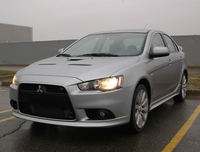2009 Mitsubishi Lancer Ralliart Review
Compare the 2009 Mitsubishi Ralliart to MazdaSpeed3 and Subaru WRX and you’ll find it a great contender...compare it to small, German performance models and you’ll find it a bargain.
2009 MITSUBISHI LANCER RALLIART REVIEW
By Steve Purdy
TheAutoChannel.com
Detroit Bureau
 |
The 2009 Mitsubishi Ralliart starts at around $26,400 and offers much of the fun and most of the wild looks of its pricier sibling. A pretty good price, I think, when compared to the physically smaller but similar in concept Subaru WRX and perhaps the youthfully cool, front-wheel drive only MazdaSpeed3. The Ralliart might be the most bang for the buck in this part of the market.
2009 Mitsubishi Ralliart power comes from the same all-aluminum, turbo 2.0-liter, intercooled, 4-cylinder we find in the Evo but with different intake plumbing and a single-scroll turbo instead of Evo’s quicker-on-the-uptake twin-scroll system. Cam profiles are the same on both cars. The Ralliart red lines about 500-rpm less than Evo (6,500 instead of 7 grand) and makes a respectable 237 horsepower (to Evo’s 291) and 253 pound-feet of torque while sharing Evo’s dual exhaust. Zero-to-60 time is about 6 seconds and EPA figures about 17-mpg in the city and 25 on the highway. I can confidently say, without accurate measurement, that our test car was not getting nearly that mileage.
That power gets to the road in an interesting fashion. The transmission is a quick-shifting, twin-clutch SST (Sequential Sportshift Transmission), six-speed automatic with a sporty personality. Sorry, no manual available in the Ralliart yet. The automatic is the same unit we find in the Evo MR, which we’ll be testing in a couple of weeks. We can almost feel what’s going on in there. Gears and clutches and other parts are not overly insulated from us – a very gratifying feel, indeed. The electronic controls are well calibrated to adjust to our instant driving style. It is almost comical how quickly it shifts all the way up to 6th gear when we’re feathering the throttle. And, even when in fully automatic ‘Drive’ mode the indicator on the 2009 Mitsubishi Ralliart dash tells us what gear we’re in. I like that.
Next is the sturdy, no-nonsense, all-wheel drive system, with helical front and mechanical rear limited slip differentials. The active center differential has 3 settings to maximize performance on different surfaces – gravel, snow and tarmac settings. We spent some time on slippery surfaces this week without any drama at all, but I didn’t push it too hard. It would be fun to do a little ice racing test sometime.
2009 Mitsubishi Ralliart suspension is firm but not nearly as firm as the Evo. Geometry is conventional with front struts and mulit-links in the rear, but with no aluminum parts like the Evo. The spring rates and dampers are calibrated to be between the mild-mannered GTS and the chaotic Evo. I think it is a good compromise. I would find daily driving of something as stiff as the Evo to be unnecessarily tedious, particularly on our busted-up Michigan roads, but the Mitsubishi Ralliart is just right. Steering is quick and predictable. Better be paying attention with this one.
 |
The driver dynamics, take a little getting used to. My pretty blonde tried to move the Mitsubishi Ralliart out of the way just after it was delivered. I wasn’t home to help and she couldn’t figure out how to get it out of ‘Park.’ She tried everything she could think of. Well, there is a little collar around the stubby shifter just under the knob that must be pulled up – the safety lock. Not a bad system once you know it’s there. The keyless start is convenient but when we shut the car of it continues running for nearly two seconds before the engine quits. What’s up with that? The paddle shifters are well-designed, being long enough to use even when turning the wheel a bit. Most of the other dynamics are good and it is more than just pleasant to drive, it’s really quite entertaining.
So, compare the 2009 Mitsubishi Ralliart to MazdaSpeed3 and Subaru WRX and you’ll find it a great contender. Compare it to the small, performance German models and you’ll find it a bargain.
MORE: Complete Mitsubishi Specs, Pics and Prices-Mitsubishi Buyers Guide
© Steve Purdy, Shunpiker Productions, All Rights Reserved



